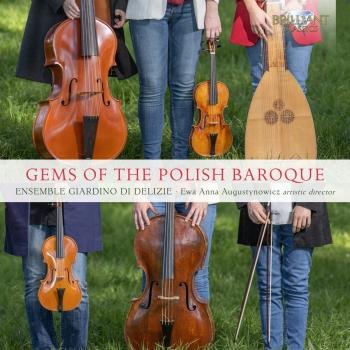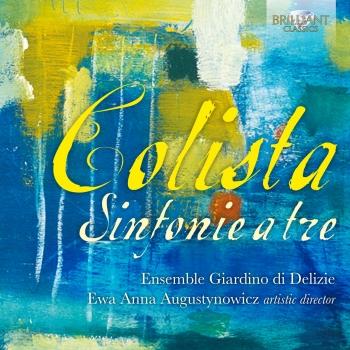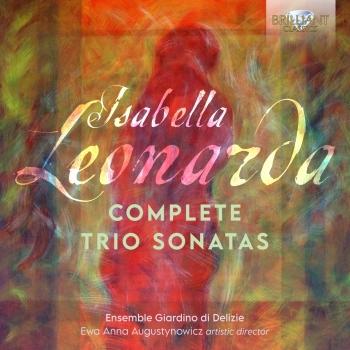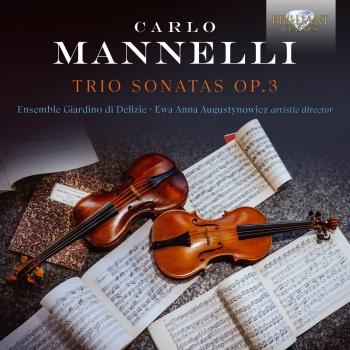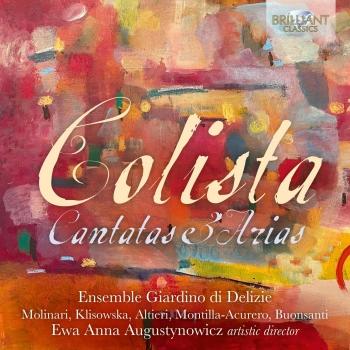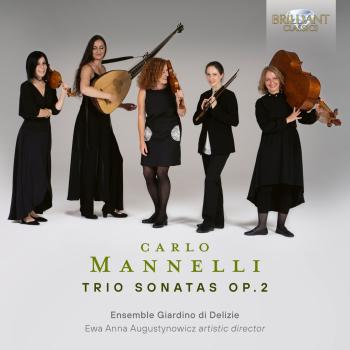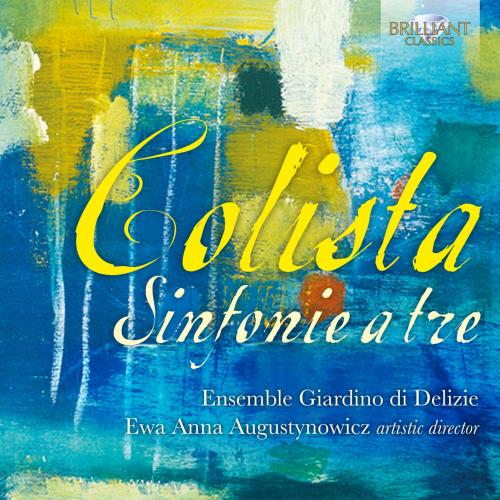
Colista: Sinfonie a Tre Ensemble Giardino di Delizie & Ewa Anna Augustynowicz
Album Info
Album Veröffentlichung:
2020
HRA-Veröffentlichung:
28.08.2020
Label: Brilliant Classics
Genre: Classical
Subgenre: Chamber Music
Interpret: Ensemble Giardino di Delizie & Ewa Anna Augustynowicz
Komponist: Lelio Colista
Das Album enthält Albumcover Booklet (PDF)
- Lelio Colista (1629 - 1680):
- 1 Sinfonia a tre in F Major, W-K26 09:05
- 2 Sinfonia a tre in A Major, W-K22 09:00
- 3 Sinfonia a tre in C Major, W-K14 04:39
- 4 Sinfonia a tre in E Minor, W-K31 07:47
- 5 Sinfonia a tre in C Major, W-K13 09:25
- 6 Sinfonia a tre in B-Flat Major, W-K28 06:20
- 7 Sinfonia a tre in G Major, W-K37 09:36
- 8 Sinfonia a tre in C Major, W-K10 05:35
- 9 Sinfonia a tre in F Major, W-K25 09:08
- 10 Ballo a tre in G Minor, W-K41 03:54
Info zu Colista: Sinfonie a Tre
Brilliant Classics presents another forgotten composer to add to its unrivalled library of Baroque rarities in modern, period-aware, world-premiere recordings.
Who was Lelio Colista (1629-1680)? Known by his early 20s as ‘the Orpheus of Rome’, he began his musical education as a choirboy before soon becoming a performer at the papal Barberini court. He then made his name as a lutenist and a theorbo virtuoso, but his talents evidently extended beyond music. He became an equrry to the Pope at the age of 26 and Keeper of the Sistine Chapel paintings from 1660 until his death around two decades later. He toured Europe widely, earning the admiration of King Louis XIV, before returning to Rome and teaching the art of lute-playing to notable composers of the next generation such as Gaspar Sanz.
Very little of Colista’s own music has been widely heard; a neglect which may be attributed to the composer’s reluctance to have it published during his lifetime. The manuscript for these nine three-part sinfonias is kept by the National Liibrary in Turin. They were performed on Christmas Eve 1664 at the Roman church of Santa Maria del Popolo and perhaps not since then, until this enterprising Polish-Italian group of period-instrument musicians has revived them for this recording.
The sinfonias all follow a satisfying template, mostly opening with a grave slow movement, and reserving the practice of strict counterpoint for the penultimate movement before the upbeat finale. Only one of the nine is cast in a minor-key, but the recording is completed by another manuscript piece, the Ballo in G minor, which plays with Baroque expressions of mourning.
Previous Brilliant Classics albums by the Ensemble Giardino di Delizie have won praise for their innovative programming and performances full of youthful verve and expression, including most recently ‘Gems of Polish Baroque’ (95955), also featuring several world-premiere recordings.
‘The performance sounds completely natural, full of spontaneity and bursting energy. It’s clear the group really likes this music and not merely try and lecture it.’ The Classic Review on Lonati Sinfonias, 95590
‘A superb album for lovers of the Baroque, to be enjoyed in silence to appreciate the smallest nuances of bow strokes and subtle variations of the basso continuo.’ Musicando on Lonati
Lelio Colista was born in Rome in 1629. Raised as a choirboy the child prodigy took Rome by storm, the “Orpheus of the city of Rome” played the guitar, lute, theorbo and harp, as well as being a dancer in the staged performances at the famous Palazzo Barberini. He worked at the courts of several Italian cities (Bologna, Firenze) before settling in Rome again, becoming a sought-after composer and teacher (one of his students was Gaspar Sanz).
This new recording contains Colista’s Sinfonias in three parts (Sinfonie a tre), played here by two violins, cello, guitar and organ. They all feature a well-structured slow first movement that is richly expressive and melodious, along with the strict counterpoint typical of the Roman School, where the fugue is often placed in the second-to-last movement. It is thus possible that they formed a model that influenced composers such as Stradella, Mannelli, Lonati and Corelli in their concepts of the Trio Sonata.
Played on period instruments by the Early Music group Ensemble Giardino Di Delizie, who already successfully recorded Sinfonias by Lonati (BC 95590) and Gems of the Polish Baroque (BC 95955) for Brilliant Classics.
Ewa Anna Augustynowicz, baroque violin, artistic director
Ensemble Giardino di Delizie
The Ensemble Giardino di Delizie
is a Roman Baroque Ensemble and was founded in 2014 by its artistic director Ewa Anna Augustynowicz, PhD. The ensemble is a collective of Polish, Italian and Eastern European musicians and has a varying structure from string duets to small chamber orchestra and its musicians specialized with internationally renowned masters, such as Enrico Onofri, Marco Ceccato, Enrico Gatti, Andrea Coen, Giovanni Togni, Dmitry Sinkowsky, Amandine Beyer, Marco Testori. Franco Pavan etc. In addition to the high level of training and specialization, the members of the group work regularly with different ensembles including Les Eléments, Divino Sospiro, Capella Cracoviensis, Accademia Montis Regalis, Europa Galante, Arianna Art Ensemble, Collegium Pro Musica, Quatuor Mosaiques, Concerto Romano, Accordone and Pomo d'Oro.
Alongside the musical activity, the ensemble also conducts research in the field of musicology with particular regard to the Roman and Polish Baroque repertoire, rediscovering forgotten authors and trying to draw bridge between these two countries. Due to its unique binational character, the ensemble is particularly interested in the peculiarities of their own musical languages. The musicians are strongly convinced of the need of “saper ben parlare per ben suonare”, thus their research starts with a proper phonetic analysis of each langugaes to make them present in the execution and interpretation of the musical pieces. Hence, their performances are rich in sweet tones of Italian Corellian passages on the one side and and vigorous and lively sounds of the Polish dances on the other side. The ensemble’s performances, particularly intense and exciting, are in fact the result of extensive historical surveys to rediscover masterpieces of Italian composers who have had the center of its activities in the Rome of Alessandro Stradella, Arcangelo Corelli and Alessandro Scarlatti during the long poignant and bright sunset of the Roman polyphonic style and those of Polish and Italian composers such as Marcin Mielczewski, Adam Jarzebski, Tarquinio Merula who had their centre of activity at the court of the Polish kings.
The ensemble is based in Rome and since its foundation pursued its activity in important institutions such as the Circle of the Armed Forces at the Ministry of Defence in Rome, Umberto Theatre, the Polish Church of St. Stanislaus in Rome, different cultural associations and others. The group participated in festivals such as the Festival of Music Rome; Almisonis Melos Chivasso, Turin; Musica Antica a San Rufo, Rieti; Sulle Ombre del Cusanino Filottrano, Marche; Santa Rita Basilica of Cascia and Concerti di Campagna, Monte Compatri. In August 2016 the ensemble performed with a great success at two important European festivals: the BRQ Vantaa Music Festival (Helsinki) and the Oude Musik Festival (Utrecht). In February 2017 the ensemble went on tournee in Poland giving concerts as a special guest at the Schola Cantorum Early Music Festival in Kalisz, at the Wilanow Palace in Warsaw and for the Societa Dante Alighieri in Katowice. In August 2017 the ensemble played with a great succes at the festival Barok na Spiszu in Poland. In 2018 Giardino di Delizie performed Polish Baroque music in various occasions celebrating 100 anniversary of the Polish independence (Turin University, Societa’ del Giardino in Milan, Museum of Instruments in Rome). In December 2018 the ensemble played in Naples for the concert series organized by Centro della Pietà de’ Turchini. The ensemble has been invited to perform during the Festival de Música Antiga dels Pirineus in Spain in 2019.
Recently, as a result of intense musicological research, the ensemble recorded its first CD for Brilliant Classics with 10 Triosonatas by Carlo Ambrogio Lonati, a still quite unknown Roman Baroque composer. It is the first modern recording of all these sonatas and Carlo Ambrogio Lonati and Roman composers are in focus of ensemble's musicological survey. In April 2019 the group has recorded its second CD, this time of the 17th century Polish Baroque Composers. This CD should be published by Brilliant Classics at the beginning of 2020. The group is already working its 3d CD with never recorded music to be recorded in the Autumn 2019. The musicians of the Giardino di Delizie perform their repertoire on historical instruments, copies of important Italian manufacturers.
Booklet für Colista: Sinfonie a Tre










